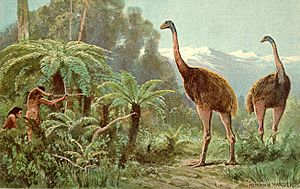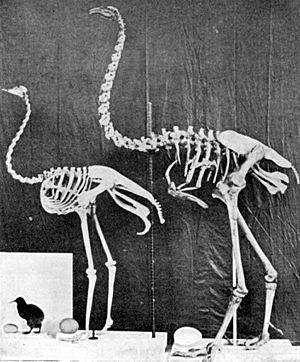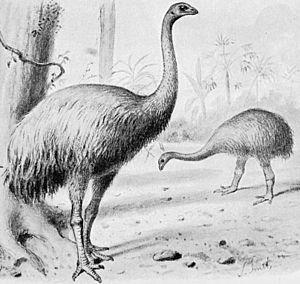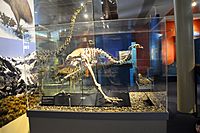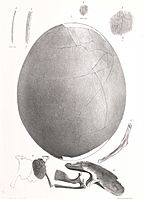Moa facts for kids
The moa were huge flightless birds that lived only in New Zealand. Sadly, they are now all extinct.
There were eleven different species of moa. They belonged to six different groups, called genera. The biggest and most famous moa was from the genus Dinornis. This giant bird could grow up to 3.6 meters (12 feet) tall! It weighed as much as 230 kilograms (510 pounds).
Moa birds had been around for a very long time, since the Cretaceous period. About a thousand years ago, the Māori people arrived in New Zealand from Oceania. Back then, many moa lived there, especially on the South Island. We know this because archaeologists have found places all over New Zealand where Māori hunted moa.
The moa became extinct about five hundred years ago. Before humans, their main predator was the huge Haast's eagle. But the moa could not survive being hunted for food by the Māori people.
Contents
Where Moa Lived
Scientists have studied moa bones found in fossils. This helps them understand where each moa species liked to live. They found that different types of moa lived in different areas.
South Island Moa
On the South Island, there were two main groups of moa. One group lived in the wet, rainy forests on the west coast. These forests had many beech trees. The Anomalopteryx didiformis (bush moa) and Dinornis robustus (South Island giant moa) lived here.
The other group lived in the drier forests and shrublands east of the Southern Alps. This area gets less rain. Here, you would find Pachyornis elephantopus (heavy-footed moa), Euryapteryx gravis, Emeus crassus, and also Dinornis robustus.
Two other moa species, Pachyornis australis and Megalapteryx didinus, might have lived in high mountain areas. P. australis is the rarest moa species. Its bones have been found in caves in the Nelson and Karamea areas. M. didinus, also called the "upland moa," was more common in mountain regions. But it also lived near the sea if the land was steep and rocky.
North Island Moa
We don't know as much about the moa on the North Island. Fewer fossil sites have been found there. But the way moa lived in different habitats was similar to the South Island.
Some moa species, like Euryapteryx gravis and Anomalopteryx didiformis, lived on both islands. But most species were found only on one island. This is because the islands were separated by water for thousands of years.
On the North Island, Dinornis novaezealandiae and Anomalopteryx didiformis lived in the wet, rainy forests. Other moa species, like Euryapteryx gravis, E. curtus, and Pachyornis geranoides, preferred drier forests and shrublands.
Moa Behavior and Life
Scientists have found about eight places with fossilized moa footprints in the North Island. These footprints show that moa walked at speeds of about 3 to 5 kilometers per hour (1.75–3 miles per hour).
Moa Diet
No one ever saw a living moa eat. But scientists figured out their diet by looking at what was left in their fossilized stomachs (called gizzards) and their fossilized droppings (called coprolites). They also studied the shape of moa skulls and beaks.
Moa ate many different kinds of plants. They ate tough twigs and leaves from low trees and shrubs. The beak of Pachyornis elephantopus was like a pair of garden shears. It could cut through tough leaves and twigs up to 8 mm thick.
Like many other birds, moa swallowed "gizzard stones" (also called gastroliths). These stones stayed in their strong gizzards. They helped grind up the tough plant material the moa ate. These stones were often smooth, round pebbles. Some stones found in moa gizzards were over 110 mm long! A Dinornis gizzard could hold several kilograms of stones. It seems moa chose the hardest pebbles to help them digest their food.
Moa Reproduction
Pieces of moa eggshell are often found in old human sites and sand dunes along the New Zealand coast. There are 36 whole moa eggs in museum collections today. They vary a lot in size, from 120 to 240 mm long and 91 to 178 mm wide. The outside of moa eggshells has tiny slit-shaped holes. Most moa eggs were white. However, the eggs of the upland moa (Megalapteryx didinus) were a blue-green color.
-
Restoration of an Upland moa
Moa and Humans
Moa Extinction
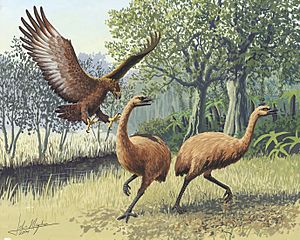
Before humans arrived, the only animal that hunted moa was the huge Haast's eagle. New Zealand had been separate from other lands for 80 million years. It had very few predators before people came. This meant its plants and animals were not used to being hunted. They were very fragile.
The Māori people arrived in New Zealand sometime before the year 1300. All types of moa were quickly hunted to extinction. Their homes were also destroyed when forests were cleared. By 1445, all moa had died out. The Haast's eagle also became extinct because it no longer had moa to eat.
New research using carbon-14 dating on old rubbish heaps (called middens) shows that the moa's extinction happened very quickly. It took less than a hundred years, not several hundred years as once thought.
Some people have wondered if a few Megalapteryx didinus moa might have lived in remote parts of New Zealand until the 1700s or even 1800s. But most scientists don't agree with this idea. Some Māori hunters said they were still hunting moa in the 1770s. However, these stories might have been about old rituals, not actual birds. Whalers and sealers also said they saw huge birds along the South Island coast. In the 1820s, a man named George Pauley claimed he saw a moa in the Otago area.
In the 1850s, an expedition reported seeing two emu-like birds on a South Island hillside. In 1861, a newspaper told of three-toed footprints measuring 36 cm (14 inches) found by a survey team. In 1878, another newspaper published a story from a farmer and his shepherd. An 80-year-old woman named Alice Mckenzie claimed in 1959 that she saw a moa in the Fiordland bush in 1887, and again when she was 17. She also said her brother saw one.
Other Large Birds
- Cassowary
- Elephant bird
- Terror birds
- Phorusrhacos
- Brontornis
- Dromornis
- Gastornis (Diatryma)
Images for kids
-
Sir Richard Owen holding the first discovered moa fossil and standing with a Dinornis skeleton, 1879
-
A preserved Megalapteryx foot, Natural History Museum
See also
 In Spanish: Dinornithidae para niños
In Spanish: Dinornithidae para niños


